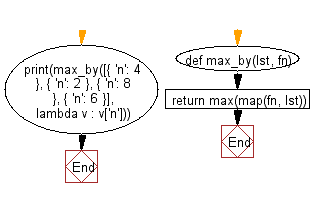Python: Maximum value of a list, after mapping each element to a value using a giving function
Max Mapped Value in List
Write a Python program to get the maximum value of a list, after mapping each element to a value using a given function.
- Use map() with fn to map each element to a value using the provided function.
- Use max() to return the maximum value.
Sample Solution:
Python Code:
# Define a function 'max_by' that takes a list 'lst' and a function 'fn'.
# It uses the 'max' function to find the maximum value in 'lst' based on the results of applying 'fn' to each element.
def max_by(lst, fn):
return max(map(fn, lst))
# Call the 'max_by' function with a list of dictionaries and a lambda function.
# The lambda function extracts the 'n' value from each dictionary.
# The function returns the maximum 'n' value from the list of dictionaries.
print(max_by([{ 'n': 4 }, { 'n': 2 }, { 'n': 8 }, { 'n': 6 }], lambda v : v['n']))
Sample Output:
8
Flowchart:

For more Practice: Solve these Related Problems:
- Write a Python program to find the maximum value from a list after applying a transformation function, and return its index as well.
- Write a Python program to determine the maximum mapped value in a list where the mapping function converts strings to their lengths.
- Write a Python program to compute the maximum value in a list after applying a custom function that squares each element.
- Write a Python program to get the maximum value from a list after mapping each element to a float, and handle potential conversion errors.
Go to:
Previous: Write a Python program to calculate the difference between two iterables, without filtering duplicate values.
Next: Write a Python program to get the minimum value of a list, after mapping each element to a value using a given function.
Python Code Editor:
What is the difficulty level of this exercise?
Test your Programming skills with w3resource's quiz.
